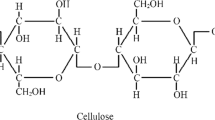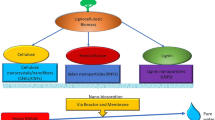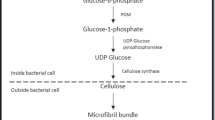Abstract
The present review describes the application of lignocellulosic biomass-derived nanocellulose for wastewater remediation with a focus on the removal of heavy metals. Nanocellulose and its nanocomposite are among the emerging materials of this century, with an abundance of application in the versatile field of composites, medicines, functional additives, and water treatment. Water treatment has received attention from the commercial and academic sector, with a large emphasis on one of the biggest problems faced by humans in the 21st century i.e., clean potable water. There are various sources of water pollution including heavy metal toxifications. The applications of cellulose and its various composites for heavy metal removal for wastewater treatment have been elaborated on in this review. Several biosorbent based on nanocellulose such as aerogels, hydrogels, ion-exchange beds, flocculants, and photocatalyst to remove heavy metal toxicity have been discussed furthermore. Research work on the effect of composites of carbon nanotube, functionalized cellulose has been covered too.
Graphic Abstract


Adapted from the permission with Zhang et al. [18]

Adapted from the permission with Phanthong et al. [8]

Adapted from the permission with Voisin et al. [34]




Similar content being viewed by others
References
Literathy P (1996) Industrial wastes and water pollution. In Regional Approaches to Water Pollution in the Environment (pp. 21–32). Springer, Dordrecht.
Sharma A, Thakur M, Bhattacharya M, Mandal T, Goswami S (2019) Commercial application of cellulose nano-composites: a review. Biotechnol Rep 21:e00316
Chen H, Sharma SK, Sharma PR, Yeh H, Johnson K, Hsiao BS (2019) Arsenic (iii) removal by nanostructured dialdehyde cellulose–cysteine microscale and nanoscale fibers. ACS Omega 4(26):22008–22020
Grenni P, Caracciolo AB, Mariani L, Cardoni M, Riccucci C, Elhaes H, Ibrahim MA (2019) Effectiveness of a new green technology for metal removal from contaminated water. Microchem J 147:1010–1020
Yang J, Hou B, Wang J, Tian B, Bi J, Wang N, Li X, Huang X (2019) Nanomaterials for the removal of heavy metals from wastewater. Nanomater. https://doi.org/10.3390/nano9030424
Mok CF, Ching YC, Osman NAA, Muhamad F, Dai Hai N, Choo JH, Hassan CR (2020) Adsorbents for removal of cationic dye: nanocellulose reinforced biopolymer composites. J Polym Res 27(12):1–15
Tasrin S, Fazil SMM, Senthilmurugan S, Selvaraju N (2021) Facile preparation of nanocellulose embedded polypyrrole for dye removal: unary and binary process optimization and seed toxicity. Int J Environ Sci Technol 18(2):365–378
Phanthong P, Reubroycharoen P, Hao X, Xu G, Abudula A, Guan G (2018) Nanocellulose: extraction and application. Carbon Res Convers 1(1):32–43
Malik DS, Jain CK, Yadav AK (2017) Removal of heavy metals from emerging cellulosic low-cost adsorbents: a review. Appl Water Sci 7(5):2113–2136
Sharma A, Mandal T, Goswami S (2017) Cellulose nanofibers from rice straw: Process development for improved delignification and better crystallinity index. Trends Carbohydrate Res 9
Tshikovhi A, Mishra SB, Mishra AK (2020) Nanocellulose-based composites for the removal of contaminants from wastewater. Int J Biol Macromol 152:616–632. https://doi.org/10.1016/j.ijbiomac.2020.02.221
Wang B, Sain M (2007) Isolation of nanofibers from soybean source and their reinforcing capability on synthetic polymers. Compos Sci Technol - Compos Sci Technol 67:2521–2527. https://doi.org/10.1016/j.compscitech.2006.12.015
Robles E, Urruzola I, Labidi J, Serrano L (2015) Surface-modified nano-cellulose as reinforcement in poly (lactic acid) to conform new composites. Ind Crops Prod 71:44–53
Yang H, Sheikhi A, van de Ven TGM (2016) Reusable green aerogels from cross-linked hairy nanocrystalline cellulose and modified chitosan for dye removal. Langmuir 32:11771–11779. https://doi.org/10.1021/acs.langmuir.6b03084
Langan P, Petridis L, O’Neill HM, Pingali SV, Foston M, Nishiyama Y, Schulz R, Lindner B, Hanson BL, Harton S, Heller WT, Urban V, Evans BR, Gnanakaran S, Ragauskas AJ, Smith JC, Davison BH (2014) Common processes drive the thermochemical pretreatment of lignocellulosic biomass. Green Chem 16:63–68. https://doi.org/10.1039/C3GC41962B
Deng S, zhang G, Chen S, Xue Y, Du Z, Wang P (2016) Rapid and effective preparation of a HPEI modified biosorbent based on cellulose fiber with a microwave irradiation method for enhanced arsenic removal in water. J Mater Chem A 4:15851–15860. https://doi.org/10.1039/C6TA06051J
Carolin CF, Kumar PS, Saravanan A, Joshiba GJ, Naushad M (2017) Efficient techniques for the removal of toxic heavy metals from aquatic environment: a review. J Environ Chem Eng 5(3):2782–2799
Zhang X, Lei H, Chen S, Wu J (2016) Catalytic co-pyrolysis of lignocellulosic biomass with polymers: a critical review. Green Chem 18:4145–4169. https://doi.org/10.1039/C6GC00911E
Sag Y, Kutsal T (2001) Recent trends in the biosorption of heavy metals: a review. Biotechnol Bioprocess Eng 6(6):376
Bilal M, Rasheed T, Sosa-Hernández JE, Raza A, Nabeel F, Iqbal H (2018) Biosorption: an interplay between marine algae and potentially toxic elements—a review. Mar Drugs 16(2):65
Park JB, Lakes RS (1992) Introduction to biomaterials. In Biomaterials (pp. 1–6). Springer, Boston, MA.
Bashir A, Manzoor T, Malik LA, Qureashi A, Pandith AH (2020) Enhanced and selective adsorption of Zn(II), Pb(II), Cd(II), and Hg(II) ions by a dumbbell- and flower-shaped potato starch phosphate polymer: a combined experimental and DFT calculation study. ACS Omega 5:4853–4867
An B, Zhao D (2012) Immobilization of As(III) in soil and groundwater using a new class of polysaccharide stabilized Fe-Mn oxide nanoparticles. J Hazard Mater 211–212:332–341. https://doi.org/10.1016/j.jhazmat.2011.10.062
Mansouri J, Harrisson S, Chen V (2010) Strategies for controlling biofouling in membrane filtration systems: challenges and opportunities. J Mater Chem 20:4567–4586. https://doi.org/10.1039/B926440J
Mahfoudhi N, Boufi S (2017) Nanocellulose as a novel nanostructured adsorbent for environmental remediation: a review. Cellulose 24:1171–1197. https://doi.org/10.1007/s10570-017-1194-0
Thakur M, Sharma A, Ahlawat V, Bhattacharya M, Goswami S (2020) Process optimization for the production of cellulose nanocrystals from rice straw derived α-cellulose. Mater Sci Energy Technol 3:328–334
Sharma A, Mandal T, Goswami S (2020) Dispersibility and stability studies of cellulose nanofibers: implications for nanocomposite preparation. J Polymers Environ 1–10
Zhang X, Elsayed I, Navarathna C, Schueneman GT, Hassan EIB (2019) Biohybrid Hydrogel And Aerogel From Self-Assembled Nanocellulose And Nanochitin As A High-Efficiency Adsorbent For Water Purification. ACS Appl Mater Interfaces 11:46714–46725. https://doi.org/10.1021/acsami.9b15139
Nascimento DM, Nunes YL, Figueirêdo MC, de Azeredo HM, Aouada FA, Feitosa JP, Dufresne A (2018) Nanocellulose nanocomposite hydrogels: technological and environmental issues. Green Chem 20(11):2428–2448
Fiorati A, Negrini NC, Baschenis E, Altomare L, Faré S, Schieroni AG, Piovani D, Mendichi R, Ferro M, Castiglione F, Mele A, Punta C, Melone L (2020) TEMPO-nanocellulose/Ca2+ hydrogels: ibuprofen drug diffusion and in vitro cytocompatibility. Materials (Basel) 13:183. https://doi.org/10.3390/ma13010183
Maestri CA, Motta A, Moschini L, Bernkop-Schnürch A, Baus RA, Lecca P, Scarpa M (2020) Composite nanocellulose-based hydrogels with spatially oriented degradation and retarded release of macromolecules. J Biomed Mater Res, Part A 108(7):1509–1519
Shak KPY, Pang YL, Mah SK (2018) Nanocellulose: recent advances and its prospects in environmental remediation. Beilstein J Nanotechnol 9:2479–2498. https://doi.org/10.3762/bjnano.9.232
Koshani R, Tavakolian M, van de Ven TGM (2020) Cellulose-based dispersants and flocculants. J Mater Chem B 8:10502–10526. https://doi.org/10.1039/D0TB02021D
Voisin H, Bergström L, Liu P, Mathew AP (2017) Nanocellulose-based materials for water purification. Nanomater (Basel Switzerland). https://doi.org/10.3390/nano7030057
Khulbe KC, Matsuura T (2021) Membrane applications. In Nanotechnology in Membrane Processes (pp. 199–343). Springer, Cham
Li Y, Cao L, Li L, Yang C (2015) In situ growing directional spindle TiO2 nanocrystals on cellulose fibers for enhanced Pb(2+) adsorption from water. J Hazard Mater 289:140–148. https://doi.org/10.1016/j.jhazmat.2015.02.051
Jamshaid A, Hamid A, Muhammad N, Naseer A, Ghauri M, Iqbal J, Shah NS (2017) Cellulose-based materials for the removal of heavy metals from wastewater–an overview. ChemBioEng Rev 4(4):240–256
Hayati B, Maleki A, Najafi F, Daraei H, Gharibi F, McKay G (2017) Super high removal capacities of heavy metals (Pb2+ and Cu2+) using CNT dendrimer. J Hazard Mater 336, 146–157. https://doi.org/10.1016/j.jhazmat.2017.02.059
Abouzeid RE, Khiari R, El-Wakil N, Dufresne A (2019) Current state and new trends in the use of cellulose nanomaterials for wastewater treatment. Biomacromol 20:573–597. https://doi.org/10.1021/acs.biomac.8b00839
Baruah J, Chaliha C, Kalita E, Nath BK, Field RA, Deb P (2020) Modelling and optimization of factors influencing adsorptive performance of agrowaste-derived Nanocellulose Iron Oxide Nanobiocomposites during remediation of Arsenic contaminated groundwater. Int J Biol Macromol 164:53–65. https://doi.org/10.1016/j.ijbiomac.2020.07.113
Anirudhan TS, Shainy F, Deepa JR (2019) Effective removal of Cobalt(II) ions from aqueous solutions and nuclear industry wastewater using sulfhydryl and carboxyl functionalised magnetite nanocellulose composite: batch adsorption studies. Chem Ecol 35:235–255. https://doi.org/10.1080/02757540.2018.1532999
Sharma PR, Sharma SK, Antoine R, Hsiao BS (2019) Efficient removal of arsenic using zinc oxide nanocrystal-decorated regenerated microfibrillated cellulose scaffolds. ACS Sustain Chem Eng 7(6):6140–6151
Sharma PR, Chattopadhyay A, Sharma SK, Geng L, Amiralian N, Martin D, Hsiao BS (2018) Nanocellulose from spinifex as an effective adsorbent to remove cadmium(II) from water. ACS Sustain Chem Eng 6:3279–3290. https://doi.org/10.1021/acssuschemeng.7b03473
Sharma PR, Chattopadhyay A, Zhan C, Sharma SK, Geng L, Hsiao BS (2018) Lead removal from water using carboxycellulose nanofibers prepared by nitro-oxidation method. Cellulose 25(3):1961–1973
Sun C, Ni J, Zhao C, Du J, Zhou C-E, Wang S, Xu C (2017) Preparation of a cellulosic adsorbent by functionalization with pyridone diacid for removal of Pb(II) and Co(II) from aqueous solutions. Cellulose. https://doi.org/10.1007/s10570-017-1519-z
Liu P, Borrell PF, Božič M, Kokol V, Oksman K, Mathew AP (2015) Nanocelluloses and their phosphorylated derivatives for selective adsorption of Ag+, Cu2+ and Fe3+ from industrial effluents. J Hazard Mater 294:177–185. https://doi.org/10.1016/j.jhazmat.2015.04.001
Hokkanen S, Repo E, Suopajärvi T, Liimatainen H, Niinimaa J, Sillanpää M (2014) Adsorption of Ni (II), Cu (II) and Cd (II) from aqueous solutions by amino modified nanostructured microfibrillated cellulose. Cellulose 21(3):1471–1487
Liu P, Sehaqui H, Tingaut P, Wichser A, Oksman K, Mathew P, A. (2014) Cellulose and chitin nanomaterials for capturing silver ions (Ag+) from water via surface adsorption. Cellulose. https://doi.org/10.1007/s10570-013-0139-5
Pillai SS, Deepa B, Abraham E, Girija N, Geetha P, Jacob L, Koshy M (2013) Biosorption of Cd(II) from aqueous solution using xanthated nano banana cellulose: Equilibrium and kinetic studies. Ecotoxicol Environ Saf 98:352–360. https://doi.org/10.1016/j.ecoenv.2013.09.003
Yu X, Tong S, Ge M, Wu L, Zuo J, Cao C, Song W (2013) Adsorption of heavy metal ions from aqueous solution by carboxylated cellulose nanocrystals. J Environ Sci 25:933–943. https://doi.org/10.1016/S1001-0742(12)60145-4
Ma H, Hsiao BS, Chu B (2012) Ultrafine Cellulose Nanofibers as Efficient Adsorbents for Removal of UO22+ in Water. ACS Macro Lett 1:213–216. https://doi.org/10.1021/mz200047q
Shen W, Chen S, Shi S, Li X, Zhang X, Hu W, Wang H (2009) Adsorption of Cu (II) and Pb (II) onto diethylenetriamine-bacterial cellulose. Carbohyd Polym 75(1):110–114
Tao H, Lavoine N, Jiang F, Tang J, Lin N (2020) Reducing end modification on cellulose nanocrystals: strategy, characterization, applications and challenges. Nanoscale horizons 5(4):607–627
Olivera S, Muralidhara HB, Venkatesh K, Guna VK, Gopalakrishna K, Kumar Y (2016) Potential applications of cellulose and chitosan nanoparticles/composites in wastewater treatment: a review. Carbohyd Polym 153:600–618
Guo X, Xu D, Yuan H, Luo Q, Tang S, Liu L, Wu Y (2019) A novel fluorescent nanocellulosic hydrogel based on carbon dots for efficient adsorption and sensitive sensing in heavy metals. J Mater Chem A 7(47):27081–27088
Ahmad M, Ahmed S, Swami B, Ikram S (2015) Adsorption of heavy metal ions: role of chitosan and cellulose for water treatment. Int J Pharmacogn 2: 280–289. https://doi.org/10.13040/IJPSR.0975-8232.IJP.2(6).280-89
Zhou Y, Wang X, Zhang M, Jin Q, Gao B, Ma T (2014) Removal of Pb (II) and malachite green from aqueous solution by modified cellulose. Cellulose 21(4):2797–2809
Vlotman DE, Ngila CJ, Ndlovu T, Malinga SP (2018) Hyperbranched polymer integrated membrane for the removal of arsenic (III) in water. J Membrane Sci Res 4(2):53–62
Mahalakshmi R, Ravikumar L, Rathina K (2017) A study on the removal of mercury (II) ions from aqueous solution by chemically modified cellulose green adsorbent: Kinetic and equilibrium studies. Rasayan J Chem 10:286–297. https://doi.org/10.7324/RJC.2017.1011633
Varghese AG, Paul SA, Latha MS (2019) Remediation of heavy metals and dyes from wastewater using cellulose-based adsorbents. Environ Chem Lett 17:867–877. https://doi.org/10.1007/s10311-018-00843-z
Wang C, Zhang Y, Liang J, Shan G, Wang Y, Shi Q (2006) Impacts of ascorbic acid and thiamine supplementation at different concentrations on lead toxicity in testis. Clin Chim Acta 370(1–2):82–88
Vaziri ND (2008) Mechanisms of lead-induced hypertension and cardiovascular disease. Am J Physiol-Heart Circul Physiol 295(2):H454–H465
Mason LH, Harp JP, Han DY (2014) Pb neurotoxicity: neuropsychological effects of lead toxicity. BioMed Res Int 2014
Pant N, Kumar G, Upadhyay AD, Patel DK, Gupta YK, Chaturvedi PK (2014) Reproductive toxicity of lead, cadmium, and phthalate exposure in men. Environ Sci Pollut Res 21(18):11066–11074
Mancuso F, Arato I, Lilli C, Bellucci C, Bodo M, Calvitti M, Aglietti MC, dell’Omo M, Nastruzzi C, Calafiore R, Luca G (2018) Acute effects of lead on porcine neonatal Sertoli cells in vitro. Toxicol In Vitro 48:45–52
Lee MY, Bae ON, Chung SM, Kang KT, Lee JY, Chung JH (2002) Enhancement of platelet aggregation and thrombus formation by arsenic in drinking water: a contributing factor to cardiovascular disease. Toxicol Appl Pharmacol 179(2):83–88
Kapaj S, Peterson H, Liber K, Bhattacharya P (2006) Human health effects from chronic arsenic poisoning–a review. J Environ Sci Health, Part A 41(10):2399–2428
States JC, Barchowsky A, Cartwright IL, Reichard JF, Futscher BW, Lantz RC (2011) Arsenic toxicology: translating between experimental models and human pathology. Environ Health Perspect 119(10):1356–1363
Argos M, Ahsan H, Graziano JH (2012) Arsenic and human health: epidemiologic progress and public health implications. Rev Environ Health 27(4):191–195
Naujokas MF, Anderson B, Ahsan H, Aposhian HV, Graziano JH, Thompson C, Suk WA (2013) The broad scope of health effects from chronic arsenic exposure: update on a worldwide public health problem. Environ Health Perspect 121(3):295–302
Duruibe JO, Ogwuegbu MOC, Egwurugwu JN (2007) Heavy metal pollution and human biotoxic effects. Int J Phys Sci 2(5):112–118
Martin S, Griswold W (2009) Human health effects of heavy metals. Environ Sci Technol Briefs Citizens 15:1–6
Bernard A (2008) Cadmium & its adverse effects on human health. Indian J Med Res 128(4):557
Karri V, Kumar V, Ramos D, Oliveira E, Schuhmacher M (2018) Comparative in vitro toxicity evaluation of heavy metals (lead, cadmium, arsenic, and methylmercury) on HT-22 hippocampal cell line. Biol Trace Elem Res 184(1):226–239
Costa M, Klein CB (2006) Toxicity and carcinogenicity of chromium compounds in humans. Crit Rev Toxicol 36(2):155–163
Gaetke LM, Chow CK (2003) Copper toxicity, oxidative stress, and antioxidant nutrients. Toxicology 189(1–2):147–163
Uriu-Adams JY, Keen CL (2005) Copper, oxidative stress, and human health. Mol Aspects Med 26(4–5):268–298
Gosens I, Cassee FR, Zanella M, Manodori L, Brunelli A, Costa AL, Bokkers BG, De Jong WH, Brown D, Hristozov D, Stone V (2016) Organ burden and pulmonary toxicity of nano-sized copper (II) oxide particles after short-term inhalation exposure. Nanotoxicology 10(8):1084–1095
Jan AT, Azam M, Siddiqui K, Ali A, Choi I, Haq QM (2015) Heavy metals and human health: mechanistic insight into toxicity and counter defense system of antioxidants. Int J Mol Sci 16(12):29592–29630
Thakur VK, Voicu SI (2016) Recent advances in cellulose and chitosan based membranes for water purification: a concise review. Carbohydr Polym 146:148–165. https://doi.org/10.1016/j.carbpol.2016.03.030
Sun X, Peng B, Ji Y, Chen J, Li D (2009) Chitosan(chitin)/cellulose composite biosorbents prepared using ionic liquid for heavy metal ions adsorption. AIChE J 55:2062–2069. https://doi.org/10.1002/aic.11797
Sharma V, Shahnaz T, Subbiah S, Narayanasamy S (2020) New insights into the remediation of water pollutants using nanobentonite incorporated nanocellulose chitosan based aerogel. J Polym Environ 28:2008–2019. https://doi.org/10.1007/s10924-020-01740-9
Singha AS, Guleria A (2014) Chemical modification of cellulosic biopolymer and its use in removal of heavy metal ions from wastewater. Int J Biol Macromol 67:409–417. https://doi.org/10.1016/j.ijbiomac.2014.03.046
Navarro RR, Sumi K, Fujii N, Matsumura M (1996) Mercury removal from wastewater using porous cellulose carrier modified with polyethyleneimine. Water Res. 30:2488–2494. https://doi.org/10.1016/0043-1354(96)00143-1
Anirudhan TS, Divya L, Parvathy J (2013) Arsenic adsorption from contaminated water on Fe(III)-coordinated amino-functionalized poly(glycidylmethacrylate)-grafted TiO2-densified cellulose. J Chem Technol Biotechnol 88:878–886. https://doi.org/10.1002/jctb.3916
Taleb K, Markovski J, Veličković Z, Rusmirović J, Rančić M, Pavlović V, Marinković A (2019) Arsenic removal by magnetite-loaded amino modified nano/microcellulose adsorbents: Effect of functionalization and media size. Arab J Chem 12(8):4675–4693
Xiong R, Wang Y, Zhang X, Lu C (2014) Facile synthesis of magnetic nanocomposites of cellulose@ultrasmall iron oxide nanoparticles for water treatment. RSC Adv 4:22632–22641. https://doi.org/10.1039/C4RA01397B
Acknowledgements
The authors would like to acknowledge Center of Innovative and Applied Bioprocessing (CIAB), Mohali for equipment and infrastructural facilities. They would like to acknowledge Department of Biotechnology (DBT), India for source of funding agencies.
Author information
Authors and Affiliations
Corresponding author
Ethics declarations
Conflict of interest
The authors declare that they have no known competing financial interests or personal relationships that could have appeared to influence the work reported in this paper.
Additional information
Publisher's Note
Springer Nature remains neutral with regard to jurisdictional claims in published maps and institutional affiliations.
Rights and permissions
About this article
Cite this article
Sharma, A., Anjana, Rana, H. et al. A Comprehensive Review on the Heavy Metal Removal for Water Remediation by the Application of Lignocellulosic Biomass-Derived Nanocellulose. J Polym Environ 30, 1–18 (2022). https://doi.org/10.1007/s10924-021-02185-4
Accepted:
Published:
Issue Date:
DOI: https://doi.org/10.1007/s10924-021-02185-4




